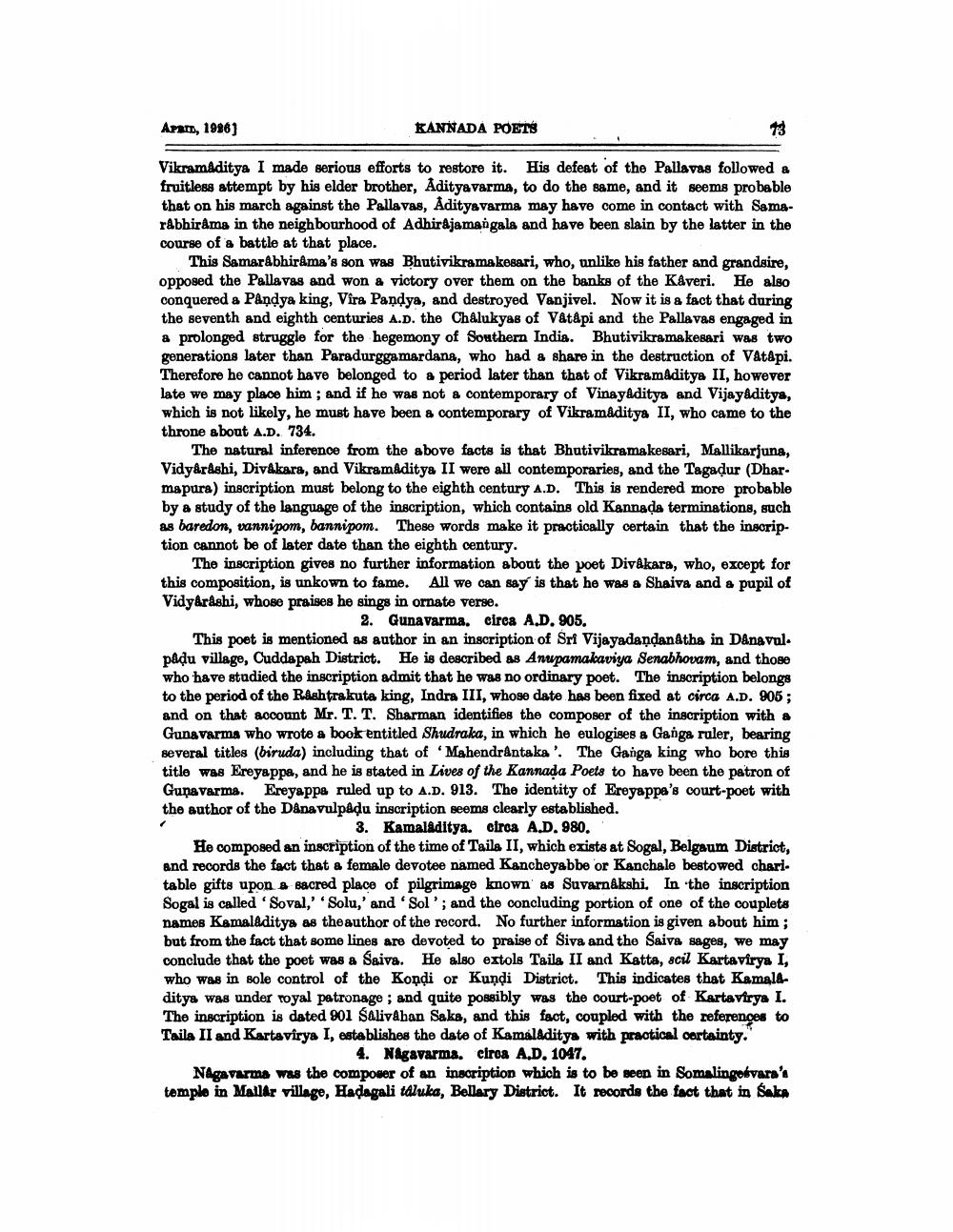________________
APRI, 1936)
KANNADA POETS
Vikramaditya I made serious efforts to restore it. His defeat of the Pallavas followed a fruitless attempt by his elder brother, Adityavarma, to do the same, and it seems probable that on his march against the Pallavas, Adityavarma may have come in contact with Samarábhirama in the neighbourhood of Adhirajamangala and have been slain by the latter in the course of a battle at that place.
This SamarAbhirAma's son was Bhutivikramakesari, who, unlike his father and grandsire, opposed the Palla vas and won & victory over them on the banks of the Kåveri. He also conquered a Pandya king, Vira Pandya, and destroyed Vanjivel. Now it is a fact that during the seventh and eighth centuries A.D. the Chalukyas of Vat&pi and the Pallavas engaged in & prolonged struggle for the hegemony of Southern India. Bhutivikramakesari was two generations later than Paradurggamardana, who had a share in the destruction of Vat&pi. Therefore he cannot have belonged to a period later than that of Vikramaditya II, however late we may place him, and if he was not a contemporary of Vinayaditya and Vijayaditya, which is not likely, he must have been a contemporary of Vikramaditya II, who came to the throne about A.D. 734.
The natural inference from the above facts is that Bhutivikramakesari, Mallikarjuna, Vidyarashi, Divakara, and Vikramaditya II were all contemporaries, and the Tagadur (Dhar. mapura) inscription must belong to the eighth century A.D. This is rendered more probable by & study of the language of the inscription, which contains old Kannada terminations, such as baredon, vannipom, bannipom. These words make it practically certain that the insoription cannot be of later date than the eighth century.
The inscription gives no further information about the poet Divakara, who, except for this composition, is unkown to fame. All we can say is that he was a Shaiva and a pupil of Vidy Arashi, whose praises he sings in ornate verse.
2. Gunavarma. circa A.D. 905. This poet is mentioned as author in an inscription of Sri Vijayadandanátha in Danaval. padu village, Cuddapah District. He is described as Anupamalaviya Senabhovam, and those who have studied the inscription admit that he was no ordinary poet. The inscription belongs to the period of the Rashtrakuta king, Indra III, whose date has been fixed at circa A.D. 905; and on that account Mr. T. T. Sharman identifies the composer of the inscription with a Gunavarma who wrote a book entitled Shudraka, in which he eulogises & Ganga ruler, bearing several titles (biruda) including that of Mahendrántaka'. The Ganga king who bore this title was Ereyappa, and he is stated in Lives of the Kannada Poets to have been the patron of Guņa varma. Ereyappa ruled up to A.D. 913. The identity of Ereyappa's court-poet with the author of the Dana vulpadu inscription seems clearly established.
3. Kamaladitya. ciroa A.D. 980. He composed an inscription of the time of Tails II, which exists at Sogal, Belgaum District, and records the fact that a female devotee named Kancheyabbe or Kanchale bestowed chari. table gifts upon a sacred place of pilgrimage known as Suvarnakshi. In the inscription Sogal is called 'Soval,' Solu,' and 'Sol'; and the concluding portion of one of the couplets names Kamaladitys as the author of the record. No further information is given about him ; but from the fact that some lines are devoted to praise of Siva and the Saive sages, we may conclude that the poet was a Saiva. He also extols Taila II and Katta, scil Kartavirya I, who was in sole control of the Kondi or Kundi District. This indicates that Kamaldditya was under royal patronage ; and quite possibly was the court-poet of Karta virya I. The inscription is dated 901 Salivahan Saks, and this fact, coupled with the references to Taila II and Kartavirya I, establishes the date of Kamaladitys with practical certainty.
4. Nagavarma. ciroa A.D. 1047. Nagavarms was the composer of an inscription which is to be seen in Somalingesvara's temple in Mallar village, Hadagali taluka, Bellary District. It records the fact that in Saka




